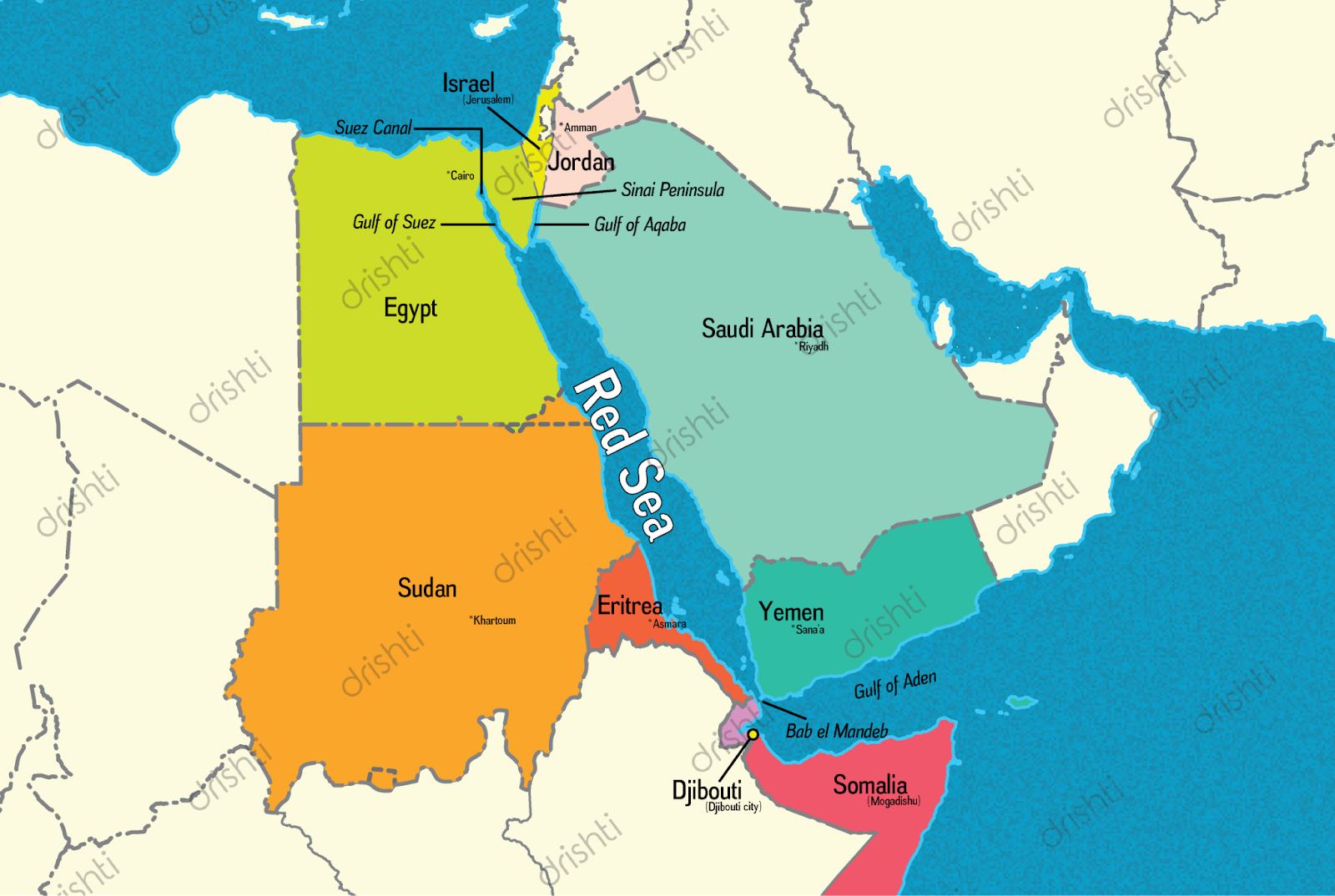International Relations
Red Sea Disruptions and India's Oil Import Dynamics
- 10 Feb 2024
- 7 min read
For Prelims: Red Sea, Persian Gulf, International Energy Agency, India's Oil Import Dynamics, PAT (Perform, Achieve and Trade), Ethanol Blending Program, FAME scheme
For Mains: Status of Oil Imports, Government’s Recent Initiatives to Control Surging Oil Demands
Why in News?
The recent turmoil in the Red Sea has sent ripples through India's oil import dynamics, triggering notable changes in its reliance on conventional suppliers like the US.
Why is India Moving its Oil Imports Away from the US?
- For a while, the US has consistently ranked among India's top five crude suppliers, with domestic refiners procuring an average of 205,000 barrels per day (bpd) of crude in 2023.
- However, recent data indicates that Indian refiners did not acquire any US crude in January 2024.
- Red Sea troubles escalated freight rates, rendering US crude economically unviable for Indian refiners. Consequently, Indian refiners reverted to traditional suppliers in the Persian Gulf (West Asia).
- Recently, Chemical tanker MV Chem Pluto was struck by a drone attack, approximately 200 nautical miles off Gujarat's coast.
- MV Chem Pluto is a Liberia-flagged, Japanese-owned, and Netherlands-operated chemical tanker.
- It had started its journey carrying crude from Al Jubail, Saudi Arabia and was expected to arrive in New Mangalore, India.
- It is believed to have been carried out by Houthi rebels based in Yemen, citing protest against Israel’s actions in Gaza.
- Recently, Chemical tanker MV Chem Pluto was struck by a drone attack, approximately 200 nautical miles off Gujarat's coast.
Who are the Top Crude-Oil Suppliers for India?
- Status of Oil Imports: India currently is the 3rd largest consumer of oil behind the US and China. It imports 85% of its oil needs and this dependence is likely to rise as domestic production falls.
- India will overtake China as the biggest driver of global oil demand in 2027. Diesel will be the single largest source of demand growth, accounting for almost half of the rise in the nation's demand (International Energy Agency).
- Major Oil Suppliers:
- Russia: Russia is currently India’s largest supplier of oil. Russian oil imports to India surged to 1.53 million barrels per day (bpd) in January, 2024.
- India capitalised on discounted Russian offers following Western sanctions on Russia (due to Russia-Ukraine Conflict), displacing traditional suppliers.
- The Urals crude oil grade of Russia has become a cornerstone of India's energy diversification efforts.
- Ira: Iraq is the second-largest source of crude supplier to India, with imports reaching 1.19 million bpd in January 2024, the highest since April 2022.
- India's efforts to diversify oil procurement channels aim to mitigate geopolitical risks and ensure a stable energy supply.
- Saudi Arabia: Saudi Arabia is India’s third-largest oil supplier and exported approximately 690,172 bpd of crude oil to India in January, 2024 maintaining its position as a key player in India's energy security landscape.
- UAE: Oil imports from the UAE surged by 81% in January, 2024 reaching around 326,500 bpd.
- Abu Dhabi is India’s fourth-largest supplier of crude oil.
- Russia: Russia is currently India’s largest supplier of oil. Russian oil imports to India surged to 1.53 million barrels per day (bpd) in January, 2024.
What are Government’s Recent Initiatives to Control Surging Oil Demands?
- Managing Demand:
- Promoting Energy Efficiency: Schemes like PAT (Perform, Achieve and Trade) incentivize industries to reduce energy consumption.
- Star labelling for appliances helps consumers choose efficient options.
- Fuel Diversification: Initiatives like the Ethanol Blending Program (EBP) aim to blend 20% ethanol with petrol by 2025, reducing gasoline dependence.
- Similarly, Compressed Natural Gas (CNG) is promoted for vehicles.
- Electric Mobility: FAME scheme is a subsidy programme aims to support electrification of public and shared transportation
- By 2030, the government intends to have an electric vehicle (EV) sales penetration of 30% for private cars, 70% for commercial vehicles and 80% for two and three-wheelers.
- Promoting Energy Efficiency: Schemes like PAT (Perform, Achieve and Trade) incentivize industries to reduce energy consumption.
- Boosting Domestic Production:
- Attractive Exploration Policies: Production Sharing Contract (PSC) regime, Discovered Small Field Policy, and Hydrocarbon Exploration and Licensing Policy (HELP) aim to attract investments in oil and gas exploration.
- Technological advancements: ONGC is investing in Enhanced Oil Recovery (EOR) techniques aimed to extract more oil from existing fields.
Way Forward
- Diversifying Biofuel Development: Beyond ethanol blending, the government can invest in research and development of advanced biofuels derived from algae, agricultural waste, and municipal solid waste.
- These biofuels can be used in transportation and industrial sectors, reducing the need for fossil fuels.
- Promoting Public Transportation and Active Mobility: Integrated public transportation systems with efficient last-mile connectivity can encourage more people to opt for sustainable modes of travel and reduce the demand for oil-based transportation fuels.
- Green Building Standards: Mandating green building standards for residential and commercial constructions can reduce energy consumption for heating, cooling, and lighting.
- Incorporating energy-efficient designs and materials in buildings can lessen the reliance on fossil fuels for electricity and heating purposes.
- Towards Hydrogen Economy: Developing India as a hydrogen economy can offer a clean alternative to traditional fossil fuels.
- Hydrogen fuel cells can be utilised in various sectors including transportation, manufacturing, and power generation.
UPSC Civil Services Examination, Previous Year Question (PYQ)
Prelims:
Q. The term ‘West Texas Intermediate’, sometimes found in news, refers to a grade of (2020)
(a) Crude oil
(b) Bullion
(c) Rare earth elements
(d) Uranium
Ans: (a)
Mains:
Q. Write a note on India’s green energy corridor to alleviate the problem of conventional energy. (2013)
Q. “Access to affordable, reliable, sustainable and modern energy is the sine qua non to achieve Sustainable Development Goals (SDGs)”.Comment on the progress made in India in this regard. (2018)







